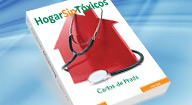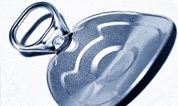Referencias científicas
- Ha sido comercializado por empresas como Bayer (con el nombre de Maklolon) y General Electric Plastic (con el nombre de Lexan).
- El bisfenol A puede estar presente, bien como parte del policarbonato (o de otros plásticos a los que también puede incorporarse) o en resinas epoxi, en una enorme cantidad de cosas. Carcasas de ordenadores, DVDs, CDs, envases de comida y bebida , equipos médicos, óptica, tapones, cristales antibalas,… También puede estar placas de circuito impreso, tuberías de agua potable, en otros plásticos diferentes del policarbonato, como el PVC, la producción de resinas de poliéster, resinas de polisulfona, resinas de poliacrilato y retardadores de llama. Además, el bisfenol A se utiliza recubrimientos de superficies, adhesivos y pinturas, papeles térmicos (como los utilizados en los recibos de caja registradora), e incluso en selladores dentales, entre otras muchas posibilidades.
A continuación citamos solo unos cuantos estudios de entre la inmensa cantidad de ellos que se han realizado sobre este asunto:
Mariscal-Arcas M, Rivas A, Granada A, Monteagudo C, Murcia MA, Olea-Serrano F Dietary exposure assessment of pregnant women to bisphenol-A from cans and microwave containers in Southern Spain. Food Chem Toxicol. 2009 Feb;47(2):506-10. doi: 10.1016/j.fct.2008.12.011. Epub 2008 Dec 24.Geens T, Apelbaum TZ, Goeyens L, Neels H, Covaci A. Intake of bisphenol A from canned beverages and foods on the Belgian market. Food Addit Contam Part A Chem Anal Control Expo Risk Assess. 2010 Nov;27(11):1627-37. doi: 10.1080/19440049.2010.508183.
Brede , C (2003). Increased migration levels of bisphenol A from polycarbonate baby bottles after dishwashing , boiling and brushsing. Food Addit Contam; 20 (7): 684-689.
Willhite CC, Ball GL, McLellan CJ. Derivation of a bisphenol A oral reference dose (RfD) and drinking-water equivalent concentration. J Toxicol Environ Health B Crit Rev. 2008;11:69–146.
J A Brotons, M F Olea-Serrano, M Villalobos, V Pedraza, and N Olea. Xenoestrogens released from lacquer coatings in food cans. Environ Health Perspect. 1995 June; 103(6): 608–612. Research Article
Goodson A, Summerfield W, Cooper I. Survey of bisphenol A and bisphenol F in canned foods. Food Addit Contam. 2002 Aug;19(8):796-802.
Noonan GO, Ackerman LK, Begley TH (2011). Concentration of bisphenol A in highly consumed canned foods on the U.S. market. Journal of Food and Agricultural Chemistry (in press): DOI: 10.1021/jf201076f.
Schecter A, Malik N, Haffner D, Smith S, Harris TR, Paepke O, Birnbaum L.Bisphenol A (BPA) in U.S. food. Environ Sci Technol. 2010 Dec 15;44(24):9425-30. doi: 10.1021/es102785d. Epub 2010 Nov 1.
Cao XL, Corriveau J, Popovic S. Sources of low concentrations of bisphenol A in canned beverage products. J Food Prot. 2010 Aug;73(8):1548-51.
Sajiki J, Miyamoto F, Fukata H, Mori C, Yonekubo J, Hayakawa K. Bisphenol A (BPA) and its source in foods in Japanese markets. Food Addit Contam. 2007 Jan;24(1):103-12.
López Cervantes J y Paseiro Losada P (2003). Determination of bisphenol A in, and its migration from, PVC stretch film used for food packaging. Food Addit Contam. 20
Cao XL, Corriveau J, Popovic S. Bisphenol a in canned food products from canadian markets. J Food Prot. 2010 Jun;73(6):1085-9.
Braunrath R., Podlipna D., Padlesak S., CichnaMarkl M. (2005). Determination of bisphenol A in canned foods by immunoaffinity chromatography, HPLC, and fluorescence detection. J Agric Food Chem 53 (23): 8911-8917.
European Commission. (2008). Updated European Risk Assessment Report 4,4‘-ISOPROPYLIDENEDIPHENOL (BISPHENOL-A). Office for Official Publications of the European Communities, Luxembourg
Lakind JS, Naiman DQ. 2010. Daily intake of bisphenol A and potential sources of exposure: 2005–2006 National Health and Nutrition Examination Survey. J Expo Sci Environ Epidemiol 21272–279.279doi:[Online 17 March 2010] doi: 10.1038/jes.2010.9.
Wilson NK, Chuang JC, Lyu C, Menton R, Morgan MK. Aggregate exposures of nine preschool children to persistent organic pollutants at day care and at home. Journal of Exposure Analysis and Environmental Epidemiology. 2003;13:187-202.
Wilson NK, Chuang JC, Morgan MK, Lordo RA, Sheldon LS. An observational study of the potential exposures of preschool children to pentachlorophenol, bisphenol-A, and nonylphenol at home and daycare. Environmental Research. 2007;103:9-20.
- Rudel RA, Gray JM, Engel CL, Rawsthorne TW, Dodson RE, Ackerman JM, et al. 2011. Food Packaging and Bisphenol A and Bis(2-Ethylhexyl) Phthalate Exposure: Findings from a Dietary Intervention. Environ Health Perspect :-. doi:10.1289/ehp.1003170 http://www.ncbi.nlm.nih.gov/pmc/articles/PMC3223004/
- Kang J-H, Kondo F, Katayama Y. Human exposure to bisphenol A. Toxicology. 2006;226:79-89.
- European Commission Opinion of the Scientific Committee on Food on Bisphenol A . Abril 2002. (http://ec.europa.eu/food/fs/sc/scf/out128_en.pdf)
- Thompson BM, Cressey PJ, Shaw IC. Dietary exposure to xenoestrogens in New Zealand. J Environ Monit. 2003;5:229-35.
- Brotons JA, Olea-Serrano MF, Villalobos M, Olea N. Xenoestrogens released from lacquer coating in food cans. Environ Health Perspect. 1994;103:608-12.
Biles JE, McNeal TP, Begley TH. Determination of bisphenol A migrating from epoxy can coatings to infant formula liquid concentrates. J Agric Food Chem. 1997;45:4697-700.
Kuo H-W, Ding W-H. Trace determination of bisphenol A and phytoestrogens in infant formula powders by gas chromatography-mass spectrometry. Journal of Chromatography A. 2004;1027:67-74.
Cao XL, Corriveau J, Popovic S. Migration of bisphenol A from can coatings to liquid infant formula during storage at room temperature. J Food Prot. 2009 Dec;72(12):2571-4.
Yoshida T, Horie M, Hoshino Y, Nakazawa H. Determination of bisphenol A in canned vegetables and fruit by high performance liquid chromatography. Food Addit Contam. 2001;18:69-75.
Goodson A, Summerfield W, Cooper I. Survey of bisphenol A and bisphenol F in canned foods. Food Addit Contam. 2002;19:796-802.
Grumetto L, Montesano D, Seccia S, Albrizio S, Barbato F. Determination of bisphenol a and bisphenol B residues in canned peeled tomatoes by reversed-phase liquid chromatography. J Agric Food Chem. 2008 Nov 26;56(22):10633-7. doi: 10.1021/jf802297z.
- Munguía-López EM, Gerardo-Lugo S, Peralta E, Bolumen S, Soto-Valdez H. Migration of bisphenol A (BPA) from can coatings into fatty-food simulant and tuna fish. Food Addit Contam. 2005;22:892-8.
- Kang J-H, Kondo F. Determination of bisphenol A in canned pet foods. Research in Veterinary Science. 2002;73:177-82.
- Kang J-H, Kito K, Kondo F. Factors influencing the migration of bisphenol A from cans. Journal of Food Protection. 2003;66:1444-7.
- Takao Y, Lee HC, Kohra S, Arizono K. Release of bisphenol from food can lining upon heating. Journal of Health Science. 2002;48:331-4.
- Nerín C, Fernandez C, Domeno C, Salafranca J. Determination of potential migrants in polycarbonate containers used for microwave ovens by highperformance liquid chromatography with ultraviolet and fluorescence detection. J Agric Food Chem. 2003;51:5647-53.
- Lopez-Cervantes J, Paseiro-Losada P. Determination of bisphenol A in, and its migration from, PVC stretch film used for food packaging. Food Addit Contam. 2003;20:596-606.
Ozaki A, Yamaguchi A, Fujita T, Kuroda K, Endo G. Chemical analysis and genotoxicological safety assessment of paper and paperboard used for food packaging. Food Chem Toxicol. 2004;42:1323-37.
Lopez-Espinosa MJ et al. Oestrogenicity of paper and cardboard extracts used as food containers. Food Addit Contam. 2007;24:95-102.
Uno de ésos estudios, por ejemplo, mostraba como el “bisfenol A había sido detectado en el 95% de las muestras examinadas a concentraciones de ≥0.1 μg/L en orina y que la media geométrica y las concentración media eran de 1.33 μg/L (1.36 μg/g creatinina) y 1.28 μg/L (1.32 μg/g creatinina), respectivamente, siendo la concentración del percentil 95th de 5.18 μg/L (7.95 μg/g creatinina)”.
Calafat, A. M., et al. (2005). “Urinary concentrations of bisphenol A and 4-nonylphenol in a human reference population.” Environ Health Perspect 113(4): 391-5.
Calafat AM, Ye X, Wong LY, Reidy JA, Needham LL. Exposure of the U.S. population to bisphenol A and 4-tertiary-octylphenol: 2003–2004. Environ Health Perspect. 2008;116:39–44.
Summary Report of Joint FAO/WHO Expert Meeting to Review the Toxicological and Health Aspects of
Bisphenol A, http://www.who.int/foodsafety/chem/chemicals/BPA_Summary2010.pdf.
Bisphenol-A and chlorinated derivatives in adipose tissue of women. Fernandez MF et al. Reprod Toxicol. 2007 AugSep;24(2):259-64. Epub 2007 Jun 26.
Evaluación de la exposición el Bisfenol-A en la población infantil de la provincia de Granada, e identificación de factores asociados. Ruiz A.M. Tesis doctoral. Universidad de Granada. 2010
Int J Hyg Environ Health. 2012 Jul 11. [Epub ahead of print]
Exposure to brominated flame retardants, perfluorinated compounds, phthalates and phenols in European birth cohorts: ENRIECO evaluation, first human biomonitoring results, and recommendations.
Casas M, Chevrier C, Hond ED, Fernandez MF, Pierik F, Philippat C, Slama R, Toft G, Vandentorren S, Wilhelm M, Vrijheid M. Environ Int. 2011 Jul;37(5):858-66. doi: 10.1016/j.envint.2011.02.012. Epub 2011 Mar 25.
Dietary exposure assessment of pregnant women to bisphenol-A from cans and microwave containers in Southern Spain. Food Chem Toxicol. 2009 Feb;47(2):506-10. doi: 10.1016/j.fct.2008.12.011. Epub 2008 Dec 24
Mariscal-Arcas M, Rivas A, Granada A, Monteagudo C, Murcia MA, Olea-Serrano F.
- PEER REVIEW REPORT FOR THE DRAFT NTP BRIEF ON BISPHENOL A from the NTP BOARD OF SCIENTIFIC COUNSELORS MEETING on June 11, 2008 . National Toxicology Program. National Institute of Environmental Health Sciences. National Institutes of Health. U.S. DEPARTMENT OF HEALTH AND HUMAN SERVICES http://ntp.niehs.nih.gov/ntp/ohat/bisphenol/BPAPeerReviewReport.pdf
- Vandenberg LN, Hauser R, Marcus M, Olea N, Welshons WV. Human exposure to bisphenol A (BPA) Reprod Toxicol. 2007;24:139–177.
Inoue et al. (2000) Determination of bisphenol A in human serum by high-performance liquid chromatography with multielectrode electrochemical detection. J Chrommatography B Biomed Sci Appl. 749 (I).17-23.
Takada et al. (1999). Bisphenol A and nonylphenols in human umbilical cords. Proceedings of the International Scientific Conference on Environmental Endocrine Disrupting Chemicals. Monte Verita, Ascona (Suiza). 7-22 March 1999.- Schonfelder et al. (2002) Parent bisphenol A accumulation in the human maternal-fetal-placental unit. Environmental Health Perspectives 110 (11) A 703-707.
- Vandenberg LN, Hauser R, Marcus M, Olea N, Welshons WV. Human exposure to bisphenol A (BPA) Reprod Toxicol. 2007;24:139–177.
- Ikezuki Y, Tsutsumi O, Takai Y, Kamei Y, Taketani Y. Determination of bisphenol A concentrations in human biological fluids reveals significant early prenatal exposure. Hum Reprod. 2002;17:2839-41.




